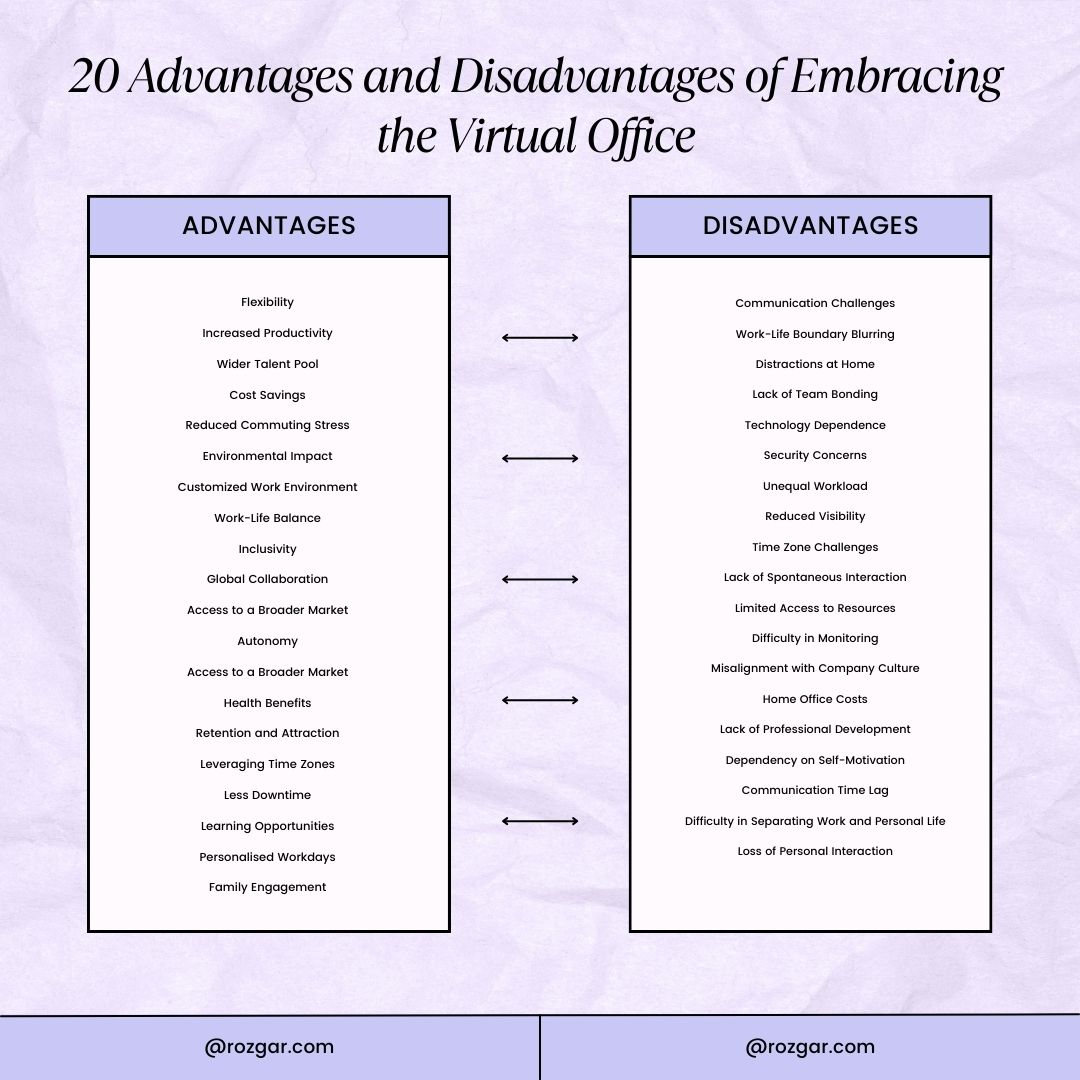
In recent years, the world has witnessed a seismic shift in the way we work. The rise of technology, coupled with unforeseen circumstances such as the global pandemic, has propelled remote work into the forefront of our professional lives. As the concept of the traditional office space evolves, its crucial to examine the advantages and disadvantages of remote work that have emerged from this transformative shift.
Advantages of Remote Work
Flexibility:
One of the most significant advantages of remote work is the flexibility it offers. Employees can design their work schedules around their personal lives, leading to better work-life balance
Increased Productivity:
For many, remote work can lead to increased productivity. Reduced office distractions and the comfort of ones environment can often result in more focused and efficient work. This is the best advantage of remote work.
Wider Talent Pool:
Companies are no longer limited to hiring local talent. Remote work allows them to tap into a global pool of skilled professionals, potentially leading to higher-quality teams.
Cost Savings:
Both employees and employers can benefit from cost savings. Employees save money on commuting and work attire, while companies can reduce expenses associated with maintaining office spaces.
Reduced Commuting Stress:
The elimination of daily commutes can significantly reduce stress levels and contribute to improved mental well-being.
Environmental Impact:
Remote work can have a positive effect on the environment by reducing carbon emissions associated with commuting and office operations.
Customised Work Environment:
Remote workers have the freedom to create a workspace that suits their preferences, contributing to a more comfortable and personalised atmosphere.
Work-Life Balance :
Remote work allows employees to better balance their work responsibilities with personal and family commitments, resulting in higher job satisfaction
Inclusivity:
Remote work can be particularly beneficial for individuals with disabilities, providing them with equal opportunities to thrive in their careers.
Global Collaboration:
Remote work encourages diverse teams to collaborate across borders and time zones, fostering a rich exchange of ideas and perspectives.
Access to a Broader Market:
Companies can expand their reach by having employees situated in different regions, gaining insights into various markets and customer preferences.
Autonomy:
Remote workers often have more autonomy over their tasks and workflow, leading to a greater sense of ownership and empowerment.
Less Office Politics:
Physical distance can mitigate office politics and foster a more harmonious work environment.
Health Benefits:
Remote work can lead to healthier lifestyle choices, as employees have more time for exercise, home-cooked meals, and sufficient sleep
Retention and Attraction:
Offering remote work options can enhance employee retention and attract top talent seeking flexible arrangements.
Leveraging Time Zones:
Teams spread across different time zones can ensure round-the-clock productivity and customer support.
Less Downtime:
Remote workers often experience fewer distractions and idle chit-chat, leading to more focused work hours.
Learning Opportunities:
Working remotely encourages self-learning and problem-solving, as employees must navigate challenges independently.
Personalised Workdays:
Remote employees can structure their workdays according to their natural rhythms, potentially leading to improved job satisfaction and performance.
Family Engagement:
Remote work allows for greater involvement in family life and the ability to attend important events without taking time off.

Disadvantages of Remote Work
Isolation and Loneliness:
Remote workers can feel isolated, missing out on the social interactions and camaraderie of an office environment.
Communication Challenges:
Effective communication can be more challenging in remote setups, leading to misunderstandings and misinterpretations.
Work-Life Boundary Blurring:
Remote work can blur the lines between work and personal life, potentially leading to burnout.
Distractions at Home:
Home environments may contain distractions that hinder productivity, such as household chores and family responsibilities.
Lack of Team Bonding:
Building strong team relationships and camaraderie is more difficult when colleagues are not physically present.
Technology Dependence:
Remote work relies heavily on technology, and technical glitches can disrupt workflow and cause frustration.
Security Concerns:
Remote work can pose security risks, especially if employees handle sensitive company data outside of secure office networks.
Unequal Workload:
Its possible for remote workers to experience an uneven distribution of tasks or be inadvertently left out of important meetings.
Reduced Visibility:
Remote employees might not receive the same recognition and advancement opportunities as those working in the office.
Time Zone Challenges:
Coordinating tasks and meetings across different time zones can lead to delays and complications.
Lack of Spontaneous Interaction:
Informal, spontaneous interactions that often lead to creative ideas and problem-solving are harder to replicate in remote settings.
Limited Access to Resources:
Remote workers might not have the same access to physical resources and office equipment as their in-office counterparts.
Difficulty in Monitoring:
Managers might find it challenging to monitor remote employees performance and ensure accountability.
Misalignment with Company Culture:
Remote workers could feel disconnected from the companys culture and values.
Home Office Costs:
Employees bear the cost of setting up a home office, including furniture, equipment, and high-speed internet.
Lack of Professional Development:
Remote workers might miss out on professional development opportunities offered within a physical office environment.
Dependency on Self-Motivation:
Remote employees need strong self-motivation to stay productive without the structure of a traditional office.
Communication Time Lag:
Waiting for responses from remote colleagues in different time zones can lead to delays in decision-making.
Difficulty in Separating Work and Personal Life:
The lack of a physical boundary between work and home can make it challenging to mentally switch off from work.
Loss of Personal Interaction:
The absence of face-to-face interaction can result in missed non-verbal cues and diminished emotional connections.
Conclusion
The advantages and disadvantages of remote work highlight the complex nature of this evolving work model. While it offers unparalleled flexibility and numerous benefits, it also comes with its share of challenges that organisations and individuals must address. The hybrid approach, combining the best aspects of both remote and in-person work, seems to be the path forward for creating a balanced and effective work environment that caters to the diverse needs of modern professionals. As technology continues to reshape the landscape of work, finding innovative ways to maximise the advantages and mitigate the disadvantages will be crucial for the future of remote work.



